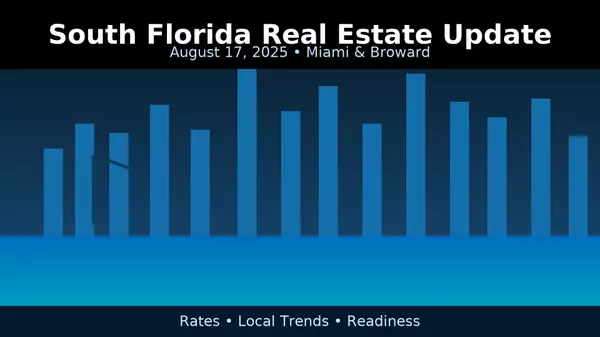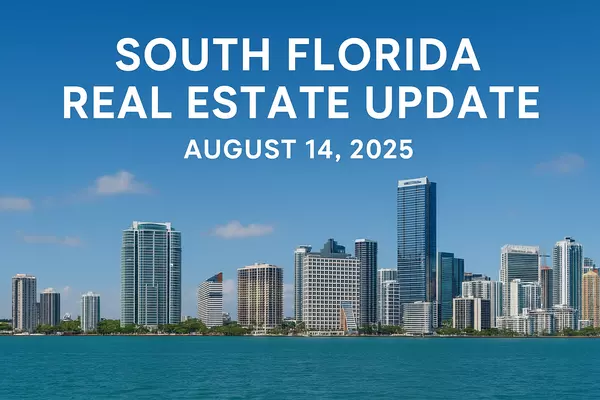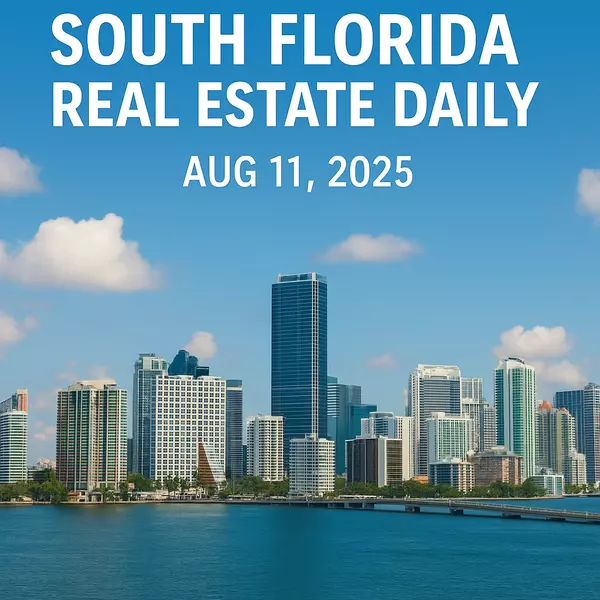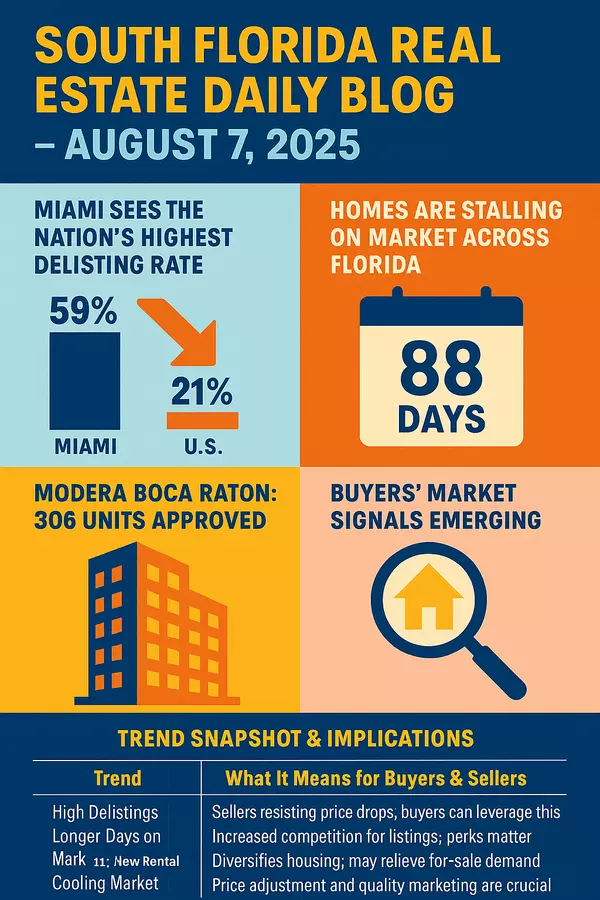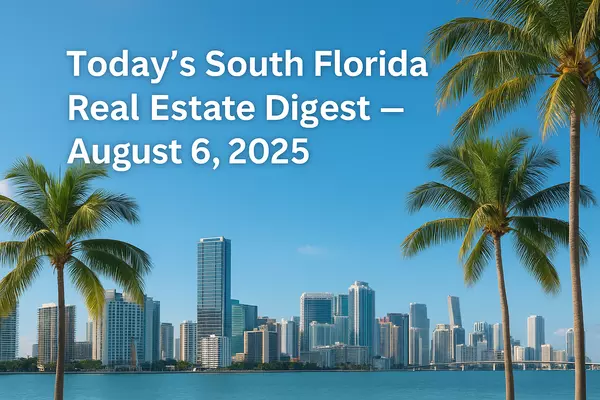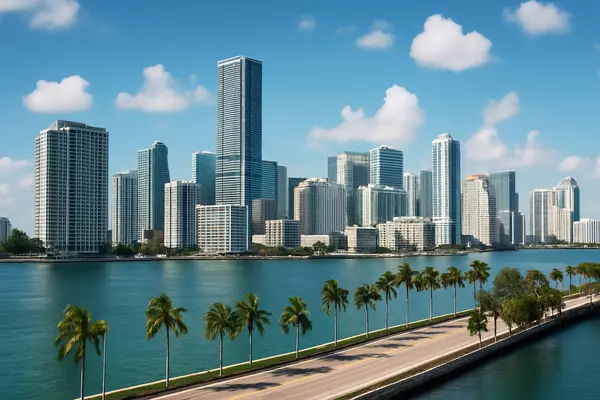Miami-Dade County Single-Family Housing Market Report – April 2025
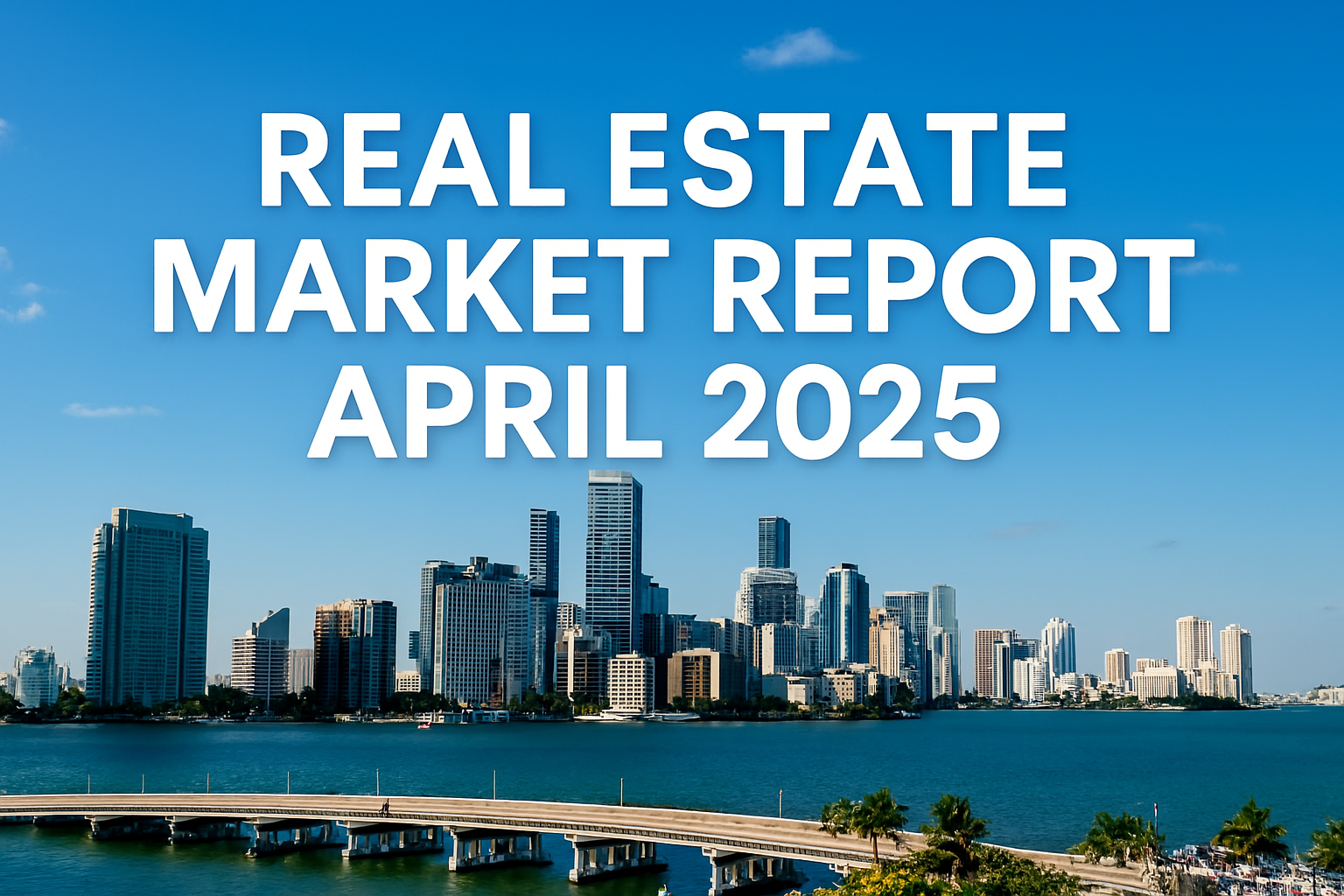
Miami-Dade County Single-Family Housing Market Report – April 2025
April 2025 Overview: The Miami-Dade single-family home market is showing signs of cooling from its frenzied peak. Prices remain near record highs but have essentially plateaued, homes are taking longer to sell, and inventory is gradually increasing. This shift toward a more balanced market comes after years of red-hot growth. Below we break down the latest statistics and trends – from median prices and days on market to inventory, interest rates, and what it all means for buyers and sellers in 2025.
Median Sales Price: Plateauing at Record Highs
After a decade of uninterrupted price gains, Miami-Dade’s single-family median sale price is leveling off in early 2025. The median price now hovers in the mid-$600,000s, roughly unchanged from a year ago. In February 2025, the median single-family home sold for $655,000, a 0.8% increase year-over-year (virtually flat growth compared to the 10%+ annual jumps seen in 2022-2023) (Miami MSA Ranked No. 2 Top Housing Market in the U.S. for 2025 - MIAMI REALTORS®). In fact, January 2025’s median hit $675,000, about 7% higher than January 2024 (Miami-Dade $1M & Up Single-Family Homes, Affordable Condo ...), tying the all-time high set at the end of 2024 (South Florida Real Estate Report - January 2025 - By The Sea Realty). But by February, prices had cooled to basically even with last year (Miami MSA Ranked No. 2 Top Housing Market in the U.S. for 2025 - MIAMI REALTORS®). Early data from March 2025 suggest a modest uptick – the median price in March was up around 4% year-over-year, rebounding about 2.9% from February’s level (Miami-Dade Real Time Market Stats - MIAMI REALTORS®).
Key takeaway: Single-family prices in Miami-Dade are holding at record levels but no longer skyrocketing. The double-digit annual appreciation of recent years has given way to low single-digit growth (Miami-Dade Total Home Sales Surge, 2024 Single-Family Home ...) (Miami MSA Ranked No. 2 Top Housing Market in the U.S. for 2025 - MIAMI REALTORS®). For sellers, that means you likely can still fetch top-dollar (prices are near historic highs), but buyers are finally seeing price stability instead of endless increases.
Sales Activity and Days on Market
Homes are not selling as instantly as they did during the pandemic boom. Sales volume has pulled back, and listings are spending more days on the market on average:
-
Closed Sales: In February 2025, about 703 single-family homes closed, down 8.0% from 764 a year earlier (). Fewer transactions indicate some softening of demand (or limited supply in certain price ranges) compared to last year. Many would-be buyers are pausing due to higher costs (more on that below), and some sellers are holding off listing, contributing to lower sales counts.
-
Days on Market: The median time to contract (days from listing to going under agreement) stretched to 46 days, up from just 35 days a year ago (). That’s a 31% increase in marketing time. Similarly, the median time from listing to final sale is now nearly 3 months (88 days), versus about 11 weeks (77 days) last year (). In other words, the typical home is taking about 1½ months to find a buyer compared to just over a month in early 2024.
-
Pricing Strategy: With longer market times, sellers have had to be more realistic. On average, homes are receiving 95.4% of their original list price, slightly less than the 96.4% a year ago (). This suggests fewer bidding wars and more instances of price reductions or negotiations. Buyers are less often paying over asking now, a stark change from the hyper-competitive behavior seen in 2021.
These trends point to a market transitioning from “white-hot” to just warm. In 2024, turnkey homes in desirable neighborhoods could attract multiple offers within days. Now in April 2025, buyers have more leverage and time – but well-priced, move-in-ready houses still sell relatively briskly. Demand hasn’t disappeared; it’s just less frantic and more price-conscious.
Inventory Levels and Months of Supply
One of the most notable shifts is in housing supply. The number of homes on the market has risen significantly from last year’s extreme lows. As of early 2025, inventory is at the highest level in years, giving buyers more options:
-
Active Listings: The inventory of active single-family listings in Miami-Dade jumped about 32% year-over-year as of February (). More sellers are listing homes than a year ago (February new listings were up 6.4% YOY ()), and with sales slowing slightly, listings are accumulating. Many buyers will notice they have a broader selection now than during 2021-2022, when inventory was scarce.
-
Months of Supply: Miami-Dade now has roughly 5.8 months of supply of single-family homes, up from about 4.4 months a year prior (). This metric means that at the current sales pace, it would take about 5.8 months to sell off all existing inventory (compared to just 4.4 months a year ago). This 31.8% increase in months’ supply firmly moves the market toward balanced conditions. (For context, 6 months of supply is often considered a balanced market between buyers and sellers, whereas anything under 5 months is a sellers’ market.) In January 2025, supply was around 5.6 months (South Florida Real Estate Report - January 2025 - By The Sea Realty) (South Florida Real Estate Report - January 2025 - By The Sea Realty), creeping up from roughly 5 months in January 2024.
What this means: Buyers are regaining some negotiating power as inventory builds. The market is still slightly in sellers’ favor by historical standards (5–6 months is borderline; 2021 had only ~2–3 months of supply, a strong seller’s market), but the trend is clearly toward more normal inventory levels. If this continues, expect more price stability and perhaps modest price discounts in segments with abundant listings. Sellers, on the other hand, face more competition and must differentiate their listings (through pricing, staging, or upgrades) to attract offers in a reasonable time.
Year-Over-Year Shifts Compared to 2024
Compared to spring 2024, the current market is markedly cooler and more balanced. Some key shifts in the past year include:
-
Price Growth Deceleration: A year ago, prices were still climbing at a rapid pace. For example, December 2024’s median price was 10.7% higher than the previous year (Miami-Dade Total Home Sales Surge, 2024 Single-Family Home ...). Now, as noted, annual appreciation has slowed to low-single digits or zero (Miami MSA Ranked No. 2 Top Housing Market in the U.S. for 2025 - MIAMI REALTORS®). Essentially, price growth has stalled out heading into 2025, a big change from the consistently high gains sellers enjoyed in prior years.
-
Rising Inventory: In early 2024, inventory was just beginning to inch up from record lows. Now in 2025, active supply is much higher (+30% YOY) (). Last year this time there were far fewer homes for sale, which gave sellers the upper hand. Today’s buyers have more choices and fewer bidding wars to contend with.
-
Cooling Demand: Homebuyer demand in Miami-Dade is still strong in absolute terms (thanks to population growth and migration), but it’s not as overheated as it was. Total sales in Q1 2024 outpaced Q1 2025 – for instance, February sales were down 8% YOY (). Open houses that would have been packed in 2022 might see more moderate attendance now. Properties are averaging several weeks longer on the market than last year () as buyers exercise more caution and take time to shop around.
-
Interest Rate Impact: In spring 2024, mortgage rates were already elevated, but many buyers were still adjusting to the new normal. By April 2025, high rates have been a reality for over a year, and their dampening effect is fully apparent in the slower sales and flattened prices. (More on rates below.)
In summary, the Miami-Dade single-family market of April 2025 looks very different from 2021’s frenzy or even early 2022. The frantic seller’s market has transitioned toward a neutral market. Sellers can’t assume every listing will sell above asking in a week, and buyers aren’t quite as stretched to their limit as before. It’s a healthier, more sustainable dynamic – though still with unique characteristics due to South Florida’s strong in-migration trend.
Buyer Demand Trends in Miami-Dade
Buyer demand in Miami-Dade remains robust but is evolving. Several factors are driving and shaping the current demand:
-
Population Growth and Migration: Miami continues to attract new residents from around the U.S. and the world. In fact, South Florida’s population is rising faster than the national average, and Miami-Dade ranked No.1 in the U.S. for net international migration recently (Miami MSA Ranked No. 2 Top Housing Market in the U.S. for 2025 - MIAMI REALTORS®). This influx of people (from relocators drawn by Florida’s climate and tax advantages, to international buyers) provides a constant stream of potential homebuyers. The world loves Miami, (Miami MSA Ranked No. 2 Top Housing Market in the U.S. for 2025 - MIAMI REALTORS®) and that underpins baseline housing demand even as local economic conditions fluctuate.
-
High-End vs. Entry-Level Demand: There is a two-tiered market emerging. The luxury segment remains very active – wealthy buyers continue to purchase high-end homes, often with cash. Sales of $1M+ single-family homes were actually up 3.6% year-over-year in early 2025 (Miami MSA Ranked No. 2 Top Housing Market in the U.S. for 2025 - MIAMI REALTORS®), defying the general cooling trend. Ultra-luxury sales (>$10M) have surged compared to a few years ago (Miami Dade Real Estate: March 2025 Update - ANALYTICS . MIAMI). This top end is bolstered by out-of-state wealth and has been “excelling” despite stock market ups and downs (Miami MSA Ranked No. 2 Top Housing Market in the U.S. for 2025 - MIAMI REALTORS®). On the other hand, the entry-level segment (if “entry level” can even be used for Miami) is severely supply-constrained. The number of affordable single-family homes has dwindled dramatically – for example, there were 86% fewer homes under $500K on the market in early 2025 than pre-pandemic (Miami Dade Real Estate: March 2025 Update - ANALYTICS . MIAMI). This “extinction of a price point” means intense competition for any home in the lower price tiers. Many local first-time buyers are effectively priced out or pushed to condos and townhomes because sub-$500K houses in Miami-Dade have become virtually nonexistent (Miami Dade Real Estate: March 2025 Update - ANALYTICS . MIAMI).
-
Buyer Sentiment: Buyers today are more cautious and price-sensitive. With economic uncertainty and higher monthly payments, many are unwilling to stretch budgets. We see this in the data – only ~95% of homes are getting their list price, fewer are selling above asking (), and price reductions are more common. Still, demand exists for well-priced, move-in-ready homes. Those properties can attract multiple offers, especially if they are in desirable neighborhoods or in that scarce sub-$600K range. But overall, buyers feel less urgency than in 2021. Some are even adopting a “wait and see” approach, hoping prices or rates might fall. Others are adjusting expectations, seeking slightly smaller or farther-out homes that fit their budget.
-
Cash Buyers and Investors: A notable portion of Miami-Dade buyers are cash buyers – roughly 38% of sales were all-cash in 2024 (Miami MSA Ranked No. 2 Top Housing Market in the U.S. for 2025 - MIAMI REALTORS®), one of the highest rates in the country. These include investors, second-home buyers, and relocating cash-rich individuals who don’t need financing. Cash buyers are less deterred by high interest rates, so they continue to buoy demand. We’re also seeing investors be selective: rental demand in Miami remains strong, but high prices mean yield is lower, so some investors are focusing on multi-family or looking to emerging neighborhoods for better deals.
Bottom line for demand: Miami-Dade’s buyer pool is still deep, fueled by demographic and migration tailwinds, but everyday buyers are feeling the affordability pinch. The market is less of a free-for-all now. Serious buyers are out there, but they are choosier, and many are approaching purchases with a mindset that they don’t have to rush or overpay – a big shift from a year or two ago.
Seller Behavior and Seller’s Market Conditions
On the flip side, seller trends have also shifted in response to the changing market. Here’s what’s happening on the supply side:
-
New Listings & Seller Motivation: After a period of hesitation, more homeowners are testing the waters by listing their homes. New listings in Miami-Dade were up about 6% year-over-year in early 2025 (). Some sellers are motivated by the still-high prices – they want to cash out near the peak. Others are people who delayed selling during the pandemic frenzy and are only now feeling comfortable that they can find their next home (perhaps moving to Broward/Palm Beach or downsizing). However, many potential sellers remain on the sidelines due to the “lock-in effect” of low interest rates – homeowners who locked in 3% mortgages in 2020-21 are reluctant to sell and then borrow at ~6-7% for a new home. This phenomenon is one reason inventory isn’t even higher.
-
Realistic Pricing is Key: Sellers now realize that overpricing a home is risky. In 2021, an overpriced listing might still get bid up by desperate buyers. In 2025, buyers will simply skip it. The average price reduction frequency has increased (reflected by that slight drop in the list-to-sale price ratio ()). Successful sellers are those who price at market value from the start. The goal is to attract a buyer within the first few weeks, before the listing goes stale. Many sellers are consulting the recent comparable sales (which in some cases may show plateaued prices) and pricing around that level instead of assuming 10% appreciation over last year’s sale.
-
Home Preparation: With more competition, homeowners are doing more to make their properties stand out. We’re seeing an uptick in staging, pre-listing renovations, and repairs. Little things – fresh paint, landscaping, decluttering – can make a big difference now. In a cooler market, buyers won’t overlook flaws as readily, so savvy sellers are ensuring their home is in tip-top shape to get the best price in a reasonable time.
-
Still a Seller’s Market? Technically, Miami-Dade is teetering on a balanced market, with ~5-6 months of inventory. By classical definition, it’s no longer a strong seller’s market once you pass 5 months supply. However, not all segments are equal. The lower-priced segment (under median) is still extremely supply-starved – any decent house under, say, $500K-$600K will get a lot of attention (since, as noted, few exist). Sellers in that bracket hold considerable power due to sheer scarcity. At the upper end, there is more inventory but also a specialized buyer pool; well-priced luxury properties can still move quickly if they offer unique features. Mid-market sellers (around the median price) face the most normalized conditions – they can expect interest but also competition from similar homes. Overall, we’ve transitioned to a scenario where sellers can sell at a great price, but it’s not a given without effort. It’s “sell’s market lite” – the advantage isn’t as heavily skewed to sellers as it was in 2022, but it’s also not fully a buyer’s market either.
Mortgage Rates and Their Impact on Buying Power
A major factor in the 2024-2025 market shift is the surge in mortgage interest rates. After remaining historically low for much of the 2010s, rates rose sharply in the past two years, dramatically affecting affordability:
-
Current Rates: As of April 2025, 30-year fixed mortgage rates are fluctuating in the mid-6% range. This follows a peak of over 7% in late 2024 – early 2025 (rates briefly hit about 7.0% in January before easing) (Joseph Crawford Group (@jcrawfordgroup) / X). Experts predict rates will hover around 6.5% to 6.7% in the short term ( What's the mortgage interest rate forecast for April 2025? - CBS News). For context, a year ago in spring 2024, rates were in the 6% range as well; two years ago (spring 2023) they were climbing through 5-6%. And just three years ago in 2021, rates were an astonishing 3% or less. The jump from ~3% to ~6.5% has roughly doubled the interest portion of a mortgage payment.
-
Affordability Crunch: Higher rates directly reduce what buyers can afford. Many buyers determine their budget based on monthly payment, not just purchase price. At a 3% interest rate, a $600,000 loan carries a principal+interest payment around $2,530/month. At a 6.5% rate, that same loan’s payment is about $3,792/month – over $1,200 more per month for the same loan amount. That huge difference forces buyers to either lower their target price or stretch their finances. In Miami-Dade, where prices are high, the effect is that some middle-class buyers have been priced out entirely compared to a few years ago, or they’ve been pushed to seek smaller/older homes than they initially wanted. The rate jump also explains why year-over-year price growth has stalled – buyers simply cannot bid prices up much further when their borrowing costs are so much higher.
-
Investor Calculus: Mortgage rates also affect investors’ and move-up buyers’ decisions. Investors who borrow to finance purchases face higher carrying costs, which can deter flips or rentals unless the deal is very compelling. Existing homeowners with a 3% mortgage are disincentivized from selling and buying a new home at 6% (they call this the “golden handcuffs” of low rates). This locks up some supply, as discussed above. In short, high rates have put the brakes on both ends – some buyers pause, and some sellers don’t list – contributing to the slower sales volume.
-
Outlook for Rates: There is some optimism that rates may gradually decline later in 2025 or 2026, but nothing is certain. The Federal Reserve’s policies, inflation readings, and economic growth all play a role. As of now, the Fed has paused rate hikes and signaled possible cuts in late 2025 if inflation subsides ( What's the mortgage interest rate forecast for April 2025? - CBS News) ( What's the mortgage interest rate forecast for April 2025? - CBS News). If the economy softens, we could see mortgage rates dip below 6% again, which would boost buying power. However, waiting for rates to drop is a gamble – and many experts say rates are more likely to stay flat in the mid-6% for the coming months ( What's the mortgage interest rate forecast for April 2025? - CBS News). Buyers and sellers should plan based on current rates rather than assuming a big change imminently.
Impact: The high borrowing costs are the main headwind for buyers right now. It’s keeping some on the sidelines and is a key reason the market isn’t as hot as it was. Yet, Miami’s demand hasn’t evaporated because many buyers here either pay cash or have significant wealth/income (mitigating the rate impact), and others are determined to buy and then potentially refinance later if rates fall. Buying power is certainly reduced – a given income qualifies for a smaller loan than before – which in turn caps how high prices can go in 2025. The era of “free money” is over, and the housing market is adjusting accordingly.
Opportunities and Advice for Buyers in 2025
For those looking to buy a home in Miami-Dade now, the changing market offers both opportunities and challenges. Here are some tips and insights for buyers navigating April 2025 conditions:
-
Leverage the Increased Inventory: With more homes on the market and properties taking longer to sell, buyers have a better chance to negotiate and shop around. You might not need to pounce on a house the day it lists or waive all contingencies (as was common in 2021). Take advantage of the selection – compare similar listings, and don’t be afraid to make an offer below asking if data supports it. If a house has been sitting for 30+ days, the seller may be willing to deal.
-
Focus on Motivated Sellers: Some sellers need to sell (due to job relocation, financial reasons, etc.) and those listings present an opportunity. Look for clues: listings that mention “price reduced” or homes that fell out of contract and came back on market. A motivated seller might offer closing cost credits, pay down your mortgage points, or be flexible on terms. Seller concessions are becoming more common now, which can help buy down your interest rate or cover repairs.
-
Mind Your Budget (and Monthly Payment): It’s still critical to get pre-approved and know what you can comfortably afford each month. Factor in today’s higher rates, insurance (which is high in Florida), and taxes. Don’t stretch to the top of your approval if it makes you house-poor. The good news is you likely won’t have to offer wildly above asking price like in the past, so you can stick closer to your budget. However, if interest rates drop in the future, be prepared for a possible surge of competition; buying now means you secure the home, and you could always refinance to a lower rate later if the opportunity arises.
-
Consider Alternative Financing or Price Ranges: If the monthly payment on your dream home is too high at current rates, consider alternatives. Some buyers are using 5/1 or 7/1 ARMs (adjustable-rate mortgages) which start with a lower rate than 30-year fixed – just be sure you have a plan for when it adjusts. Others are looking slightly below their max price and plan to invest in renovations over time, rather than buying a fully updated home at a premium. Also, expand your search radius – areas just outside the hottest neighborhoods or in the path of development may offer better value and upside potential.
-
Be Ready to Act for the Right Home: While you do have more breathing room now, good homes priced well will still sell fast. When a new listing that checks all your boxes hits the market, be ready to tour it and put in an offer. The market isn’t dead – we still see multiple offers on exceptional listings (e.g. a Coral Gables updated house or a turnkey home in Pinecrest at a reasonable price). Have your financing and documents in order so you can move quickly when it counts. Essentially, pick your battles: you can be patient overall, but when that gem appears, don’t sleep on it.
Buyer outlook: This spring could actually be one of the best times in recent memory to be a Miami buyer in terms of negotiating power. You likely won’t face the craziness of 20 competing offers. You might snag a home at or even below list price with some perks. Just remain mindful of the cost of owning that home (with higher rates and insurance) and plan for the long term. If prices stay flat or even dip slightly in certain segments, don’t be discouraged – think of your home as a 5+ year investment. The fundamentals of Miami (population growth, limited land, global appeal) are strong, so buying when the market is calmer could pay off in equity gains down the road.
Opportunities and Advice for Sellers in 2025
If you’re considering selling your home in Miami-Dade, 2025 is still a favorable time – but it requires a more strategic approach than during the frenzy. Here’s how sellers can make the most of the current market:
-
Price it Right from the Start: Pricing is the critical decision. Aim to list at a fair market price, not an aspirational one. Overpricing will likely backfire now that buyers have options. Look closely at recent comps (sales in the last 2-3 months, not last year’s peak) and price just slightly above or even at that level. Remember, if you price competitively, you might still incite a mini bidding scenario or at least get close to asking. If you overshoot, your home could sit on the market and ultimately sell for less after price cuts. The first two weeks of listing are your golden window to attract buyer interest – make your price compelling in that window.
-
Optimize Presentation: In a more balanced market, presentation matters. Take the time to prepare your home before listing. This means decluttering, deep cleaning, making any minor repairs, and perhaps staging key rooms to look their best. High-quality photos and even video/drone footage can make your listing stand out online (where almost all buyers will see it first). Consider investing in curb appeal – fresh mulch, flowers, a new front door paint job – to create a great first impression. These efforts can result in a quicker sale and higher offers. In 2025, buyers are picky: a well-presented, move-in-ready home will attract a premium because many buyers don’t want to take on projects right after paying so much to buy.
-
Be Patient and Flexible: Even with a perfectly priced and prepped home, it may take a few weeks to sell. Don’t be discouraged if you don’t get an offer in the first week. The average time to contract is now 6-7 weeks (), so temper your expectations compared to the overnight sales you heard about in 2022. If a few weeks pass with little action, be ready to adjust – whether that means a price reduction or addressing feedback (e.g. if buyers consistently mention an issue, consider fixing it or offering a credit). Also, be flexible with showings and responsive to offers. An offer slightly below your asking price might be worth negotiating rather than rejecting outright, especially if it’s a solid buyer.
-
Highlight Your Home’s Strengths: With more competition on the market, make sure to market your home’s unique features. If you have a larger lot, a new roof, impact windows, a desirable school district, or a great view – promote that in your listing and marketing materials. Target likely buyer demographics for your area (for example, if you’re selling a family home near good schools, emphasize the family-friendly aspects). In Miami, don’t forget to play up any lifestyle perks – proximity to the beach, a pool or outdoor entertaining space, local parks, etc. Emotional appeal can set your property apart.
-
Consider Timing: Traditionally, spring is a good time to sell, and we are in spring. The market has a decent number of active buyers now. Looking ahead, if mortgage rates do tick down later in 2025, buyer demand could increase – but that could also be met with a surge of new listings. There’s a case to sell now while inventory is creeping up but not too high, and before any potential economic changes. That said, every situation is different. If you’re not in a rush, keep an eye on market indicators (months supply, interest rates) and aim to list when conditions in your sub-market are favorable (e.g. if you notice inventory in your neighborhood is tightening or a neighbor sold fast, that could be a good sign).
Seller outlook: Miami-Dade sellers in 2025 can still achieve excellent results. Home values are near record highs, meaning most sellers have substantial equity. By pricing smartly and putting in the work to show your home in the best light, you can attract serious buyers even in this calmer atmosphere. Homes that are turnkey and well-priced are still selling – and sometimes with multiple offers – in this market. The key difference is you may not have dozens of bidders or see above-asking offers unless your home truly checks all the boxes. Work with your real estate agent to understand your local micro-market, be realistic, and you can successfully capitalize on the still-strong prices in Miami. Remember, you’re likely also going to become a buyer somewhere after you sell – so a more balanced market can work in your favor on the next purchase.
Conclusion: A Shifting but Resilient Market
The Miami-Dade single-family market in April 2025 is navigating a new phase. After an explosive run-up in prices and a severe inventory crunch, we’re finally seeing signs of normalization. Prices have flattened (even dipped slightly in inflation-adjusted terms), inventory is up, and the insane competition has cooled. Yet, this is by no means a downturn – think of it as the market catching its breath. South Florida remains a highly sought-after region, and that fundamental demand will likely keep a floor under prices.
For buyers, conditions are the most favorable they’ve been in years in terms of selection and negotiating ability – albeit counterbalanced by the hurdle of higher mortgage rates. For sellers, it’s still a chance to sell at historically high price points, but success now comes from smart strategy rather than just riding a wave of demand. Both parties should stay informed: watch the trends in inventory, pricing, and interest rates as 2025 progresses.
Going forward, if interest rates ease, we could see another bump in activity; if they rise further or the economy slows, the market might tip more toward buyers. In any scenario, Miami’s unique appeal and growing population mean it should outperform many other markets. The frenzy of 2021 may be behind us, but Miami-Dade real estate in 2025 remains strong, just in a more sustainable, level-headed way. Whether you’re looking to buy or sell, understanding these current trends will help you make the most of the opportunities in this evolving market.
Sources:
-
MIAMI Association of Realtors – Market Reports & Press Releases (Miami MSA Ranked No. 2 Top Housing Market in the U.S. for 2025 - MIAMI REALTORS®) (Miami-Dade Total Home Sales Surge, 2024 Single-Family Home ...) (Miami-Dade $1M & Up Single-Family Homes, Affordable Condo ...) (Home price and sales statistics for Miami-Dade County)
-
Florida Realtors / SunStats – Miami-Dade County Housing Data (Feb 2025) () (Year-over-year changes in sales, inventory, days on market, etc.)
-
Analytics Miami – Market Analysis (Miami Dade Real Estate: March 2025 Update - ANALYTICS . MIAMI) (Insights on inventory by price point and market dynamics)
-
Forbes Advisor / CBS News – Mortgage Rate Trends (Joseph Crawford Group (@jcrawfordgroup) / X) ( What's the mortgage interest rate forecast for April 2025? - CBS News) (Current mortgage rate levels and forecasts)
-
By The Sea Realty – South Florida Real Estate Report Jan 2025 (South Florida Real Estate Report - January 2025 - By The Sea Realty) (Regional perspective on prices and inventory in South Florida)
-
MIAMI Realtors – Buyer Demand Indicators (Miami MSA Ranked No. 2 Top Housing Market in the U.S. for 2025 - MIAMI REALTORS®) (Miami MSA Ranked No. 2 Top Housing Market in the U.S. for 2025 - MIAMI REALTORS®) (Migration and cash sales data illustrating demand drivers)
Categories
Recent Posts

